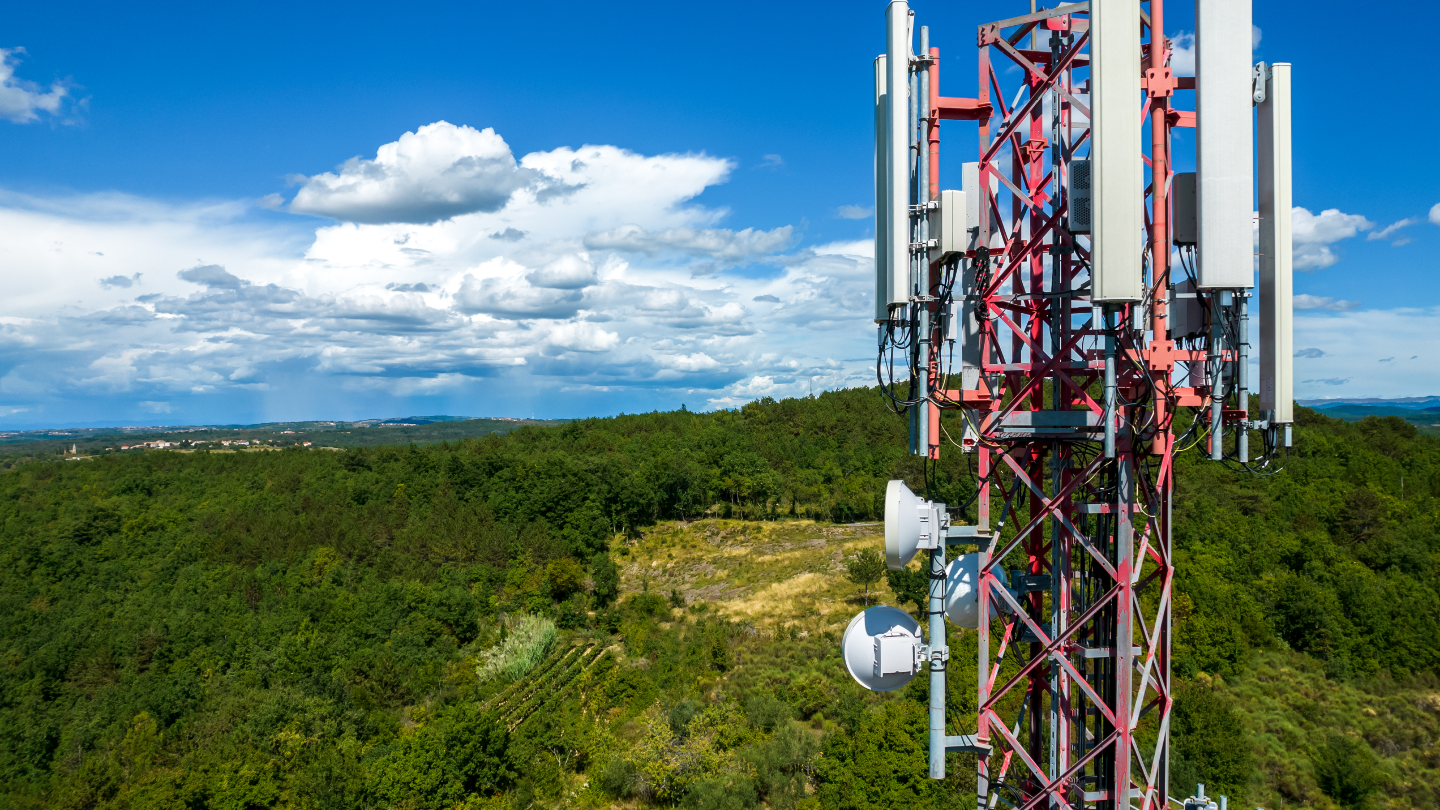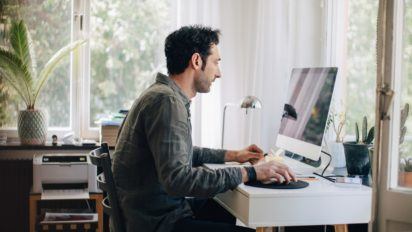If you spend any time at all connected to the internet, whether via a computer or a mobile device, you’ll have heard of 5G. This fifth-generation cellular wireless technology allows you to use your cell phone and have an internet connection, all from the same tower.
The hope for 5G tech is that it will not only revolutionize tech, medical and scientific industries but also help to cheaply connect more rural households to the internet that fiber or cable cannot reach. The lack of affordable or available internet connections is often called the digital divide.
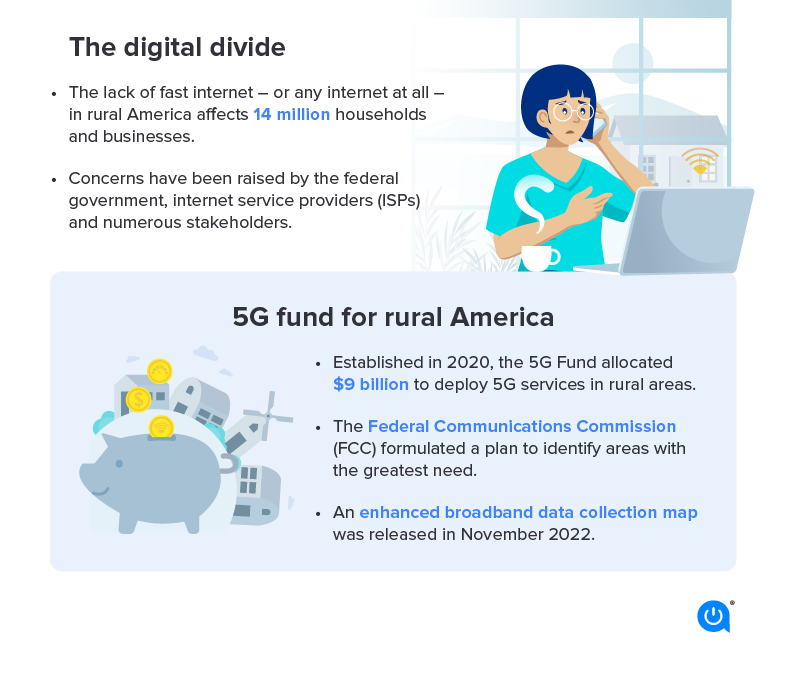
What is 5G and how does 5G work?
5G is an evolution of the 4G or 4G LTE wireless data you may still use with your smartphone or devices.
The current 5G network is built on a series of 5G Radio Access Network (RAN) towers and small cell base stations. The RAN towers are used for less densely populated areas. These use radio waves that are capable of covering a significant amount of distance but are less equipped to handle lots of demand.
One of the benefits that these towers experience on the 5G technology is carrier aggregation, which allows Mobile Network Operators (MNOs) to combine the abilities of their towers to improve overall connectivity and provide additional coverage over a larger area. This is made possible by Orthogonal Frequency Division Multiplexing (OFDM), which allows information to be transmitted over a range of frequencies rather than being restricted to a common frequency.
The base stations handle more densely populated spaces, using small cell antennas that communicate using millimeter waves (mmWave). This technology carries data much faster, achieving the speeds necessary for the modern mobile network. However, these stations can only cover short distances. The base stations, sometimes called macro cells, use multiple input, multiple output (MIMO) antennas that send and receive high-band radio frequencies to transfer data.
These stations and towers are also connected to fiber optic cables connecting to the Mobile Backhaul (MBH) network. That connects the mobile network to wireline networks, which are then connected to data centers and servers worldwide.
One way to think of these towers and stations is basically as a big router. They provide a wireless network for you to connect to, but they send much of the data via underground wires and cables. These stations use beamforming to determine the most efficient route for delivering data to a user, just like a router determines how best to route data to a device on its network.
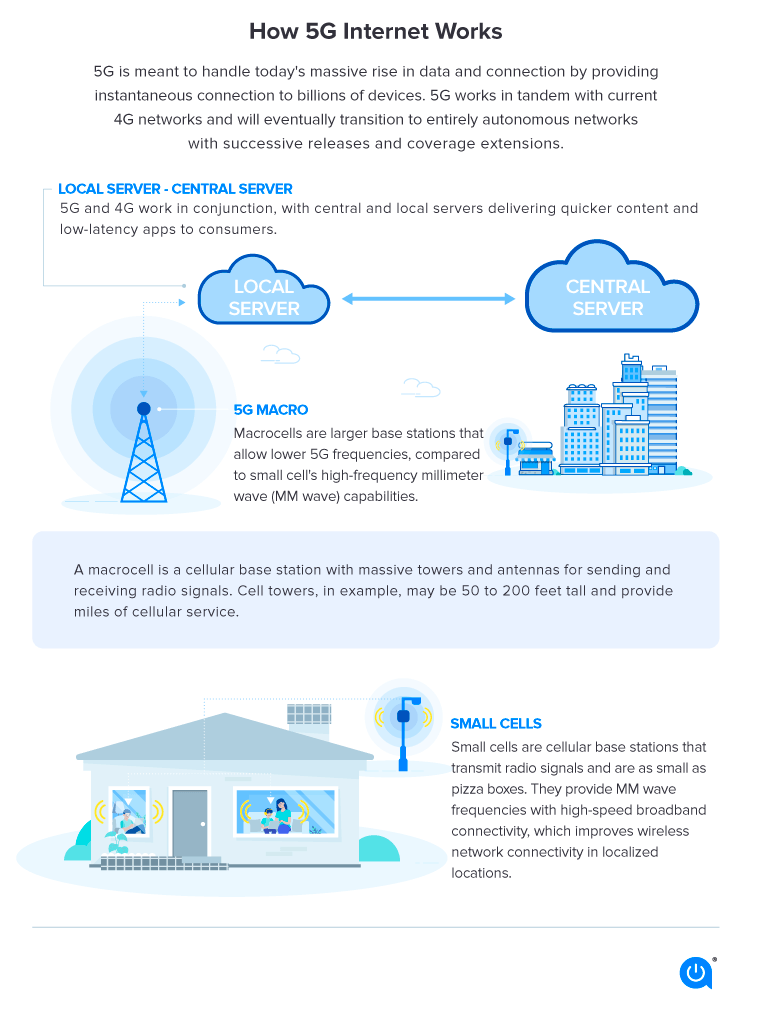
How is 5G different from 4G?
Basically, the difference between 4G and 5G is speed and capability. You can do more faster with a 5G connection.
Time to download a 2-hour movie on 5G vs. 4G vs. 3G networks
| 5G network | 4G network | 3G network |
|---|---|---|
| 3.6 seconds | 6 minutes | 26 hours |
5G focuses on massive device connectivity with reduced latency — in other words, how quickly data transfers between a source and its destination — and a higher data rate. Where 5G outperforms current technology is in its speed and connectivity.
According to a Qualcomm study, the average consumer was expected to use nearly 11 GB of data per month on their smartphone in 2022, with the popularity of video use explaining the uptick.
5G allows the fast consumption of video, plus new medical and corporate innovations, the Internet of Things growth, artificial intelligence, virtual reality, cloud access and more.
5G can also be used as a fixed wireless broadband connection, which is in growing demand. You just need a receiver in your home. 5G cellular towers and other sites beam 5G radio waves to that gateway, which converts the radio waves to a home Wi-Fi connection.
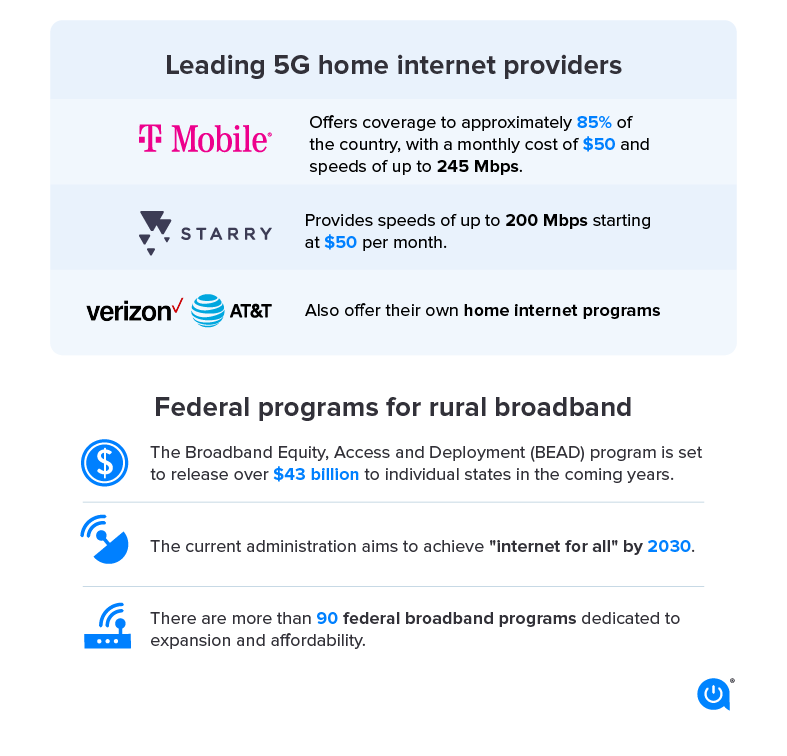
Which ISPs offer 5G home internet?
There are four major players in the 5G home internet space. Each offers the low-latency 5G is known for, with the ability to use the nearest 5G cell tower to power your internet connection.
T-Mobile 5G Home Internet
T-Mobile offers one plan with a flat $50/mo. with taxes included and no price hikes or hidden fees. With T-Mobile 5G, you’ll get download speeds of up to 245 Mbps and upload speeds of up to 31 Mbps.
Starry
Starry provides speeds up to 300 Mbps for $50, along with two higher speed levels, up to 1,000 Mbps. The downside to Starry is its limited availability. Currently available in five major U.S. markets: Boston, Denver, Los Angeles, New York and Washington, D.C., Starry does plan expansion.
Verizon 5G Home Internet
Verizon’s 5G internet plan is the cheapest, starting at $25/mo. for up to 300 Mbps if you bundle it with your Verizon cell phone plan. It’s available in 900 cities in the U.S. and growing all the time. If you aren’t in a serviceable area for 5G, Verizon’s 4G LTE internet is available in parts of nearly every state except for Oregon, New Mexico, Nevada, Texas and Arizona.
AT&T Internet Air
AT&T’s new 5G home internet connection service, AT&T Internet Air, will cost users $55/mo., plus taxes. If you add an eligible AT&T wireless (mobile) plan within the first 30 days, you can get the new plan for $35/mo.
The benefits of 5G
Perhaps the biggest advantage that 5G provides is speed. The fully realized 5G network can provide download rates of up to 20 gigabits per second. That is 100 times faster than 4G, and are speeds that will be essential to the development of new connected technologies, as well as making it possible to do things like stream content and play games while on a mobile network.
Likewise, 5G can achieve much lower latency, which is the time between when a device sends data and how long it takes to receive a response. The 5G network can have latency under 10 milliseconds, while 4G networks typically perform closer to 60 to 100 milliseconds. That allows for a much faster real-time exchange of data and less delay.
Because of how 5G operates, by allowing for carrier aggregation and relying on more stations to provide short-wave communication, reliability also improves. There is more support for densely populated areas so coverage is not lost to congestion, and more sparsely populated spaces can be covered by carriers using multiple bands to transfer data.
A significant amount of build-out must occur to make 5G a universal reality, available everywhere. This creates economic opportunity to both build and maintain the infrastructure.
The technology itself also opens up significant possibilities as new technology and opportunities come available due to reliable and wide-reaching internet connectivity.
5G presents the possibility of providing internet service to underserved areas where wireline services don’t currently reach, opening those areas up to the ability to connect in new ways, including creating workforce and educational opportunities.
5G internet issues
While 5G technology is an essential development, it is also a major undertaking with some initial drawbacks. One of those are myths and rumors about health concerns, mostly unfounded. Other issues include:
Network security
5G tech does come with a greater risk of security breaches. These include denial-of-service (DDoS) attacks and more vulnerability for hackers. Security protocols are going in place, but it’s a large network and will take some time to keep it protected like 4G.
Cost of 5G development
Building out the 5G network has been, and continues to be, costly. Not only do providers need to spend money to maintain current towers and equipment, but they also need to install upgrades for the new 5G antennas. On top of that, the antennas need to have a radio frequency to travel to reach receivers, so providers must pay for spectrum bands at government auctions. “In a single auction for U.S. spectrum in 2019, AT&T and T-Mobile spent just shy of $1.8 billion combined,” reported Quartz.
Availability
5G isn’t available everywhere, but it is growing. T-Mobile and Verizon are mobile communications giants, with towers across the U.S., so they had a solid network to launch 5G services on. Now, T-Mobile is one of the most widely available fixed wireless networks available in parts of all 50 states, serving about 75% of the U.S. See if T-Mobile home internet is available in your state.
Verizon is available in 900 cities across the country and is expanding. Verizon’s coverage map shows areas in red where its 5G Home Internet is available. If you’re not serviceable for 5G Home Internet, Verizon’s 4G LTE internet is available in parts 45 states.
Starry is currently available in five major U.S. metro areas in Boston, Denver, Los Angeles, New York and Washington, D.C., with plans to expand to 47 more markets in the next couple of years.
AT&T just launched its 5G home internet service, AT&T Internet Air, and hopes to expand in the next few years.
5G skills
With new technology comes the need for specialists to run and expand it. “A private 5G network is often ideal inside a manufacturing plant, big-box retail establishment, or office complex, but installing and maintaining a private 5G network could require a skills upgrade for an organization,” states T-Mobile.
The demand for 5G-skilled workers is real and will only continue to grow. T-Mobile, when offering their services to businesses, uses this example, “The healthcare field offers its own range of possibilities and requirements … 5G promises to give people in rural communities access to medical specialists without traveling to and from a big city. Such uses will require AI-enabled cameras, 3D imaging, and the integration of sensors and other equipment, as well as new technologies that might include holography—all of which demand the skills to operate and maintain those systems.”
People with skills in edge computing, artificial intelligence and machine learning, data science and cyber security will continue to be in great demand.
What can 5G be used for?
Consumers can use 5G for everything they use 4G for, like streaming, video creation and viewing, gaming, working from home and more. With its capability to keep billions of devices running, it’s a beacon for expansion in the areas of artificial intelligence and virtual reality to advance the medical, scientific and tech fields.
5G frequently asked questions
Although not as fast as a fiber connection, 5G home internet is a solid choice if it’s available to you, mainly due to its low latency and low monthly cost.
You can game on a 5G home internet connection because it offers such low latency, or lag, so your game won’t stop and start or freeze. Cable and fiber are more stable options for hardcore gamers, however, due to their reliability. 5G home internet can be unstable, especially in high-traffic times.
Yes, at around $50/mo., 5G home internet is cheaper than the $65 and up per month of some cable companies. Fiber and satellite can run in the triple digits per month. 5G ISPs also have no hidden fees, so the price you see is what you pay.
5G can deliver faster speeds than 4G in theory. As the build out continues, speeds will get faster. Right now, the key 5G home internet ISPs offer around 200 to 300 Mbps.
5G is the latest iteration of mobile technology that has existed since 1984. It was developed as part of research in South Korea in 2008 and designed in part by researchers at New York University in 2012.
5GE is not technically 5G, but is instead a 4G LTE-A network that is faster than standard 4G LTE but is slower than 5G.
6G is being developed but is not expected to be available until at least 2030.
We value your feedback
Was this page helpful?
We value your feedback
We’re glad! Tell us what helped most on this page.
We value your feedback
Was this page helpful?
Thanks for your feedback!
Your insight helps, and we’ll do our best to improve your experience.
Allconnect: Let us compare providers for you
Why should you choose Allconnect? We’re the #1 broadband marketplace in the U.S, meaning you can trust us to search, compare and order internet and TV service for your home.
Get started
Written by:
Robin LaytonEditor, Broadband Content
Robin Layton is an editor for the broadband marketplace Allconnect. She built her internet industry expertise writing and editing for four years on the site, as well as on Allconnect’s sister site MYMOVE.com. …
Read more

Edited by:
Camryn Smith-
Featured
![AT&T expands 5G home internet service]() AT&T expands 5G home internet service Robin Layton — 2 min read
AT&T expands 5G home internet service Robin Layton — 2 min read -
Featured
![What is a good internet speed?]() What is a good internet speed? Camryn Smith — 7 min read
What is a good internet speed? Camryn Smith — 7 min read -
Featured
![ACP program allows eligible households to get high-speed internet for free]() ACP program allows eligible households to get high-speed internet for free Robin Layton — 2 min read
ACP program allows eligible households to get high-speed internet for free Robin Layton — 2 min read
Latest
-
Thursday, July 25, 2024
Worried about losing your signal? This is how to keep your satellite dish cleanDavid Anders — 6 min read
-
Tuesday, July 23, 2024
The best free TV and movie streaming services 2024Camryn Smith — 5 min read
-
Tuesday, July 23, 2024
Everything you need to know about internet speedsRobin Layton — 8 min read


